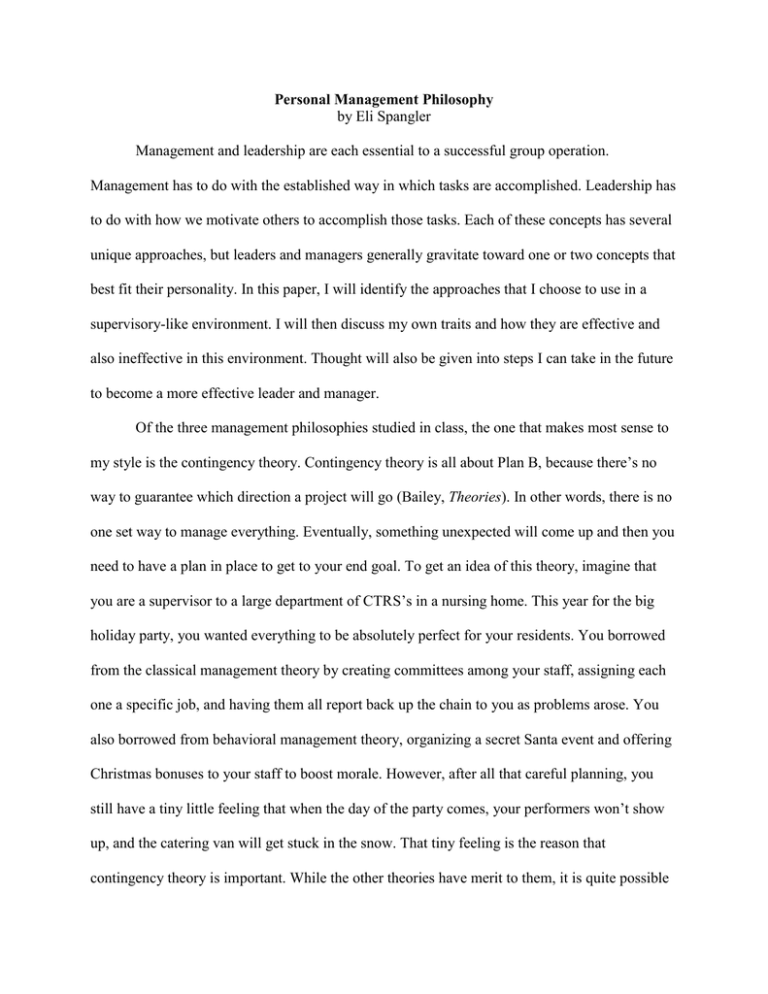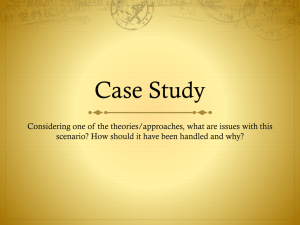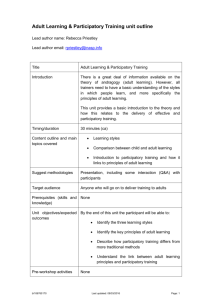Management Philosophy
advertisement

Personal Management Philosophy by Eli Spangler Management and leadership are each essential to a successful group operation. Management has to do with the established way in which tasks are accomplished. Leadership has to do with how we motivate others to accomplish those tasks. Each of these concepts has several unique approaches, but leaders and managers generally gravitate toward one or two concepts that best fit their personality. In this paper, I will identify the approaches that I choose to use in a supervisory-like environment. I will then discuss my own traits and how they are effective and also ineffective in this environment. Thought will also be given into steps I can take in the future to become a more effective leader and manager. Of the three management philosophies studied in class, the one that makes most sense to my style is the contingency theory. Contingency theory is all about Plan B, because there’s no way to guarantee which direction a project will go (Bailey, Theories). In other words, there is no one set way to manage everything. Eventually, something unexpected will come up and then you need to have a plan in place to get to your end goal. To get an idea of this theory, imagine that you are a supervisor to a large department of CTRS’s in a nursing home. This year for the big holiday party, you wanted everything to be absolutely perfect for your residents. You borrowed from the classical management theory by creating committees among your staff, assigning each one a specific job, and having them all report back up the chain to you as problems arose. You also borrowed from behavioral management theory, organizing a secret Santa event and offering Christmas bonuses to your staff to boost morale. However, after all that careful planning, you still have a tiny little feeling that when the day of the party comes, your performers won’t show up, and the catering van will get stuck in the snow. That tiny feeling is the reason that contingency theory is important. While the other theories have merit to them, it is quite possible that a single unfortunate event can render them useless. Many CTRS’s avoid this disaster situation in programming by always having a “hip-pocket” activity such as trivia available. I can think of a specific experience in the field that led me to contingency theory. Emergency responders must learn the Incident Command System for mass-casualty events, which is arranged exactly like classical management theory suggests, so that everyone has a job and everyone reports to someone. Unfortunately, in 2013 we got a call for a shooting in Chesterfield, and we responded with two units, eight men total. Four of us, all under 21, were new to EMS and this was our first shooting. We were overwhelmed with the chaos and the number of police, fire, and news vehicles when we arrived. The drivers and medics from both of our units loaded-up with the patient, who was in bad shape, leaving the four of us on scene looking very out of place. Panicking and not knowing how to proceed, we ended-up driving the ambulance back to the station, illegally, with our crew chief giving us instructions the whole way back. The moral of this story is that even though we spent long hours studying incident command, when the moment came, everyone abandoned the chain of command and forgot their role. Our plan B, though it was on-the-spot, saved us from staying on scene too long and making our agency look bad to other responders. This situation was nobody’s fault, but it probably could have been avoided if we had created a contingency plan. This management style requires analysis and some prediction of outcomes, but in the end I believe contingency planning always pays off. In terms of leadership styles, I learned from my test results that I am a participatory leader. According to Kendra Cherry at About.com Psychology (2006), the participatory leader takes ideas from the group before exercising their position to make the final decision. This leader is one with the group, not removed or on a different level, and is ready to roll sleeves up and work with the group. While this may not be as quick or efficient as if the leader told the group exactly what to do, it is effective because it allows group members the freedom to collaborate and grow (Bailey, Leadership Styles and Theories). Another reason it is a good leadership style is because it can result in members feeling more important, and usually this means they will contribute more creativity and enthusiasm over time. I came to this leadership style over a number of years. The first leadership position I was ever given was when I was 14 years old, and I was made the section leader of the baritones in my high school marching band. I got section leader because I was the best player, even though older students tried for the position. I tried to run the section like the military, criticizing them when they got notes wrong and shushing them when they spoke, whispered, and even when they laughed on the field. I lost friends quickly, and soon there was no more section at all. I learned that even though I may know more details than someone else, it doesn’t mean that I am better suited to be in charge. That is why I personally feel more confident in a group, because if my idea is radical or sure to fail, there so many other ideas to choose from. In the workplace, I will absolutely be using this leadership style. If I do not, then I am likely to make a lot of decisions that are best for me and not for everybody else. Imagine if we need to hold a weekly staff meeting, but I schedule it after the weekly pool program because that’s when I have lunch; meanwhile all my staff is late because they have to take residents back to their rooms. I bet they could all agree on a better time that would result in a more productive meeting, all I would have to do is ask their input. However, I as the leader need to have the final say, because I was put in that position for a reason, and I may need to steer the group in a different direction. A group may be tempted to argue back against that decision, but if the leader has earned their respect by making them feel important, they are likely to let him or her keep that leadership. Overall, however, I have found that a participatory style truly does increase motivation and feelings of value from group members. I think the most important part of leading a group is being open minded. Openmindedness is the one core value that I believe can connect you to all the other values in people. For example, I may have an employee who is very authoritative, and who assumes leadership without my permission whenever I leave the room, stating how he thinks things should be done. Keeping an open mind allows me to identify the strength of his leadership, and to find value in that piece of him as a person. I may even find a special role for him, or change his job title, so that he feels more responsible for his team’s success. Open-mindedness will also allow the supervisor to listen to more ideas from the group which could possibly help to achieve the common goal. Closed-minded people often shoot-down ideas, and that is no way to build a team. Another value that I feel strongly about is being polite. I understand that everyone has their own style, particularly in electronic communication; I’m okay with informal communications most of the time. On the other hand, I always notice when someone neglects to say “please” and “thank you”. This is an easy way to make people feel important, yet many people neglect that opportunity. An employee who feels important is more likely to apply their skills when they are asked for. It also improves the work environment, and encourages behaviors such as sharing and perhaps chivalry. At first, having to remember to say“please” and “thank you” may feel annoying , but soon it will become a passing habit, and you will still give people that boost by showing them respect. The last value that would be present in my ideal supervisory environment is that of each person taking 100% responsibility for their actions. This was a concept introduced to our class last semester, and I have internalized it a great deal. This means no blaming others, no making excuses, and no rationalization to save yourself from consequences. Taking responsibility for a mistake is an excellent way to save time, rather than trying to sort out the details of which people were at fault at which instant, and who should get in more trouble. I am far less likely to become frustrated with someone who took responsibility for a mistake up-front than with someone who waited a day or two to come forth with the truth. A byproduct of this practice is increased trust within a department, and increased accountability amongst coworkers. So far I’ve identified my ideal management theory as contingency theory, my ideal leadership style as participatory, and my top three management values as open-mindedness, politeness, and 100% responsibility. Now I’d like to focus on my inherent characteristics which have led me to appreciate those concepts. One strength that I possess is that of empathy. Putting myself in other peoples’ shoes is extremely helpful in times of negotiation and conflict. By empathizing with the other person, I can usually see where they are coming from, based on their background and their personality. I do not have to agree with them, but if I can make sense of why they are feeling that way, it allows me to control my emotions and avoid a conflict. In a supervisor position, this actually helps me approach my employees. I ask myself, “How could I present this task in such a way that they will be interested and take some leadership?” Another strength that I have is that I need to have things planned-out. I rarely make lastminute plans, partly because it stresses me out and partly because I am already busy with things that I planned far in advance. In a group setting, this is helpful because it is hard for deadlines to sneak-up. It is also helpful because when you ask a group to schedule far in advance with you, such as a rehearsal for a presentation, the group typically feels more confident before that meeting even occurs because. A third strength that I have is that I am analytical. As soon as someone presents an idea, I am usually already playing-out in my head all the scenarios that might come of it. At times, I will pick-up on a piece of the puzzle that a less analytical person might have ignored, and together we can adapt our plan before it becomes a problem. Analytical skills also allow me to consider consequences of, for example, a disciplinary conversation before it happens. Emotions are usually involved when it comes to delivering consequences, but in the past I have been able to find a way to have the conversation and not hurt the person. That being said, I do have some areas I need to work on as well. The first area, one that I’m actively working on this week, is that of setting boundaries. My professors helped me realize that sometimes I am so interested in either making the other person comfortable or avoiding conflict, that I let others take advantage of me. In a supervisory role, continuing this behavior would be a great way for me to lose authority and credibility with my employees. My plan to improve in this area is to start very small, in simple interactions with friends. A friend might ask me to help them with a problem they are having with a friend while I still have homework that needs to be done, and I will simply tell them I need to take care of my homework before I take care of them. As I get more comfortable, I will begin setting boundaries ahead of time, such as telling my current supervisees at work, “I need each of you to commit to two office hours a week,” to spread the workload so that it does not all fall on me. Another weakness I have is that I try very hard not to show frustration. To clarify, I do not think that angry outbursts or heated discussions are a good way to solve anything. However, I stifle even the slightest bit of frustration that I experience, and it leads to me stifling other emotions that come with it. This can negatively affect a one-on-one relationship with an employee, because I am not being honest and open about my feelings. To change this about myself, I need to change my opinion about being frustrated. There is nothing negative about calmly telling someone else, “What you’re saying frustrates me because…” and then having an honest conversation about it. What I will do (and have started to do) is tell my closer friends when I am frustrated, and then see how they react. From there I can move on to telling people I’m not so comfortable with, and see if the reaction changes. I will likely begin to realize that admitting frustration could actually improve my relationships with people. In a supervisory setting, setting the expectation of expressing feelings at the workplace in a calm and honest manner, will increase the self-awareness of my employees, and allow them to focus more on the real issues that come-up. A third weakness I have is that, at times, I incorrectly assign my priorities. Being involved in a number of things means that I divide my time frequently. Sometimes this means that I have to choose between two commitments, and occasionally I choose poorly. This can look like me staying late at work to finish a project, and arriving to class tardy. It can also look like me missing class entirely because I feel that I am needed in another role somewhere else. This reflects poorly on my judgement, because I came to college to be a student, and therefore being a student should always be my number one priority. When I become a supervisor later in life, it will be important for me to set priorities for my employees, and hold them accountable, so that they keep “the main thing the main thing” (Cottrell, 2002). I must master this important skill myself before I can expect others to do it. I’ve begun to correct this by setting expectations with other people. My current supervisors know that my primary role is a student, and that I can’t miss class for any reason. I also have started an accountability group with two other friends. We call each other every Friday morning and talk about our goals for the week, and what we got accomplished last week. They call me out when I say that I missed class or didn’t get a top priority item done, and they ask me what my plan is to get it done the next week. Clearly, there are a lot of different pieces which go into puzzles such as management and leadership. In order to better conceptualize my styles of participatory leadership and contingency management, and to see their interaction with my core values, strengths, and weaknesses, please see the visual representation below. Notice that core values are at the base of my management and leadership. My strengths and weaknesses surround my core values, and my overarching management and leadership styles are supported by my strengths, weaknesses, and core values. Theories of Supervising Employees Strengths Weaknesses Core Values • Contingency Management Theory • Participatory Leadership • Empathetic, Planning, Analytical • Needs to Set Boundaries, Show Feelings, and Prioritize • Open-Minded • Polite • 100% Responsibility References Bailey, A. Leadership Styles & Theories [PowerPoint slides]. Retrieved from Canvas website: https://canvas.longwood.edu/courses/1230447/files/48843381?module_item_id=1109751 8 Bailey, A. Theories [PowerPoint slides]. Retrieved from Canvas website: https://canvas.longwood.edu/courses/1230447/files/49818869?module_item_id=1140726 6 Cherry, K. A. (2006). Leadership Styles. Retrieved September 20, 2015 from http://psychology.about.com/od/leadership/a/leadstyles.htm Cottrell, D (2002). Monday morning leadership: 8 mentoring sessions you can’t afford to miss. Dallas, TX: Corner Stone leadership Institute.


